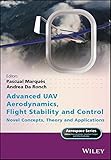Advanced UAV aerodynamics, flight stability, and control : novel concepts, theory and applications / edited by Pascual Marques, Andrea Da Ronch.
Contributor(s): Marqués, Pascual [editor.] | Da Ronch, Andrea [editor.]
| Da Ronch, Andrea [editor.] .
.
Material type:  BookSeries: Aerospace series (Chichester, England): Publisher: Chichester : John Wiley & Sons, 2017Edition: First edition.Description: 1 online resource (xvii, 754 pages).Content type: text Media type: computer Carrier type: online resourceISBN: 9781118928691; 1118928695; 9781118928714; 1118928717.Subject(s): Drone aircraft
BookSeries: Aerospace series (Chichester, England): Publisher: Chichester : John Wiley & Sons, 2017Edition: First edition.Description: 1 online resource (xvii, 754 pages).Content type: text Media type: computer Carrier type: online resourceISBN: 9781118928691; 1118928695; 9781118928714; 1118928717.Subject(s): Drone aircraftIncludes bibliographical references and index.
Print version record.
Title Page ; Copyright Page; Contents; List of Contributors; Series Preface; Preface; Companion Website; Chapter 1 Advanced UAV Aerodynamics, Flight Stability and Control:: An Introduction; 1.1 Unmanned Aircraft Aerodynamics; 1.2 UAV Flight Stability and Control; Chapter 2 Aerodynamics of UAV Configurations ; 2.1 Introduction; 2.2 Emerging Technologies in UAV Aerodynamics; 2.3 Aerodynamics and Stealth Compromises; 2.4 Rotor Blade Tip Aerodynamics; 2.5 Flight Dynamics of Canard Aircraft; 2.6 Aerodynamics of the UCAV 1303 Delta‐wing Configuration
2.7 Flow Structure Modification using Plasma Actuators2.8 Conclusion; References; Part I Novel Concepts in Unmanned Aircraft Aerodynamics ; 1.1 Fixed-wing (airplanes); Chapter 3 Aerodynamic Performance Analysis of Three Different Unmanned Re-entry Vehicles ; 3.1 Introduction; 3.2 Vehicle Description; 3.3 Flight Scenario and Flow‐regime Assessment; 3.4 Rarefied and Transitional Regimes; 3.5 Viscous-interaction Regime ; 3.6 High-temperature Real-gas Regime ; 3.7 Laminar-to-turbulent Transition Assessment ; 3.8 Design Approach and Tools; 3.9 Aerodynamic Characterization
3.10 Low-order Methods Aerodynamic Results 3.11 CFD-based Aerodynamic Results ; References; Chapter 4 Nonlinear Reduced-order Aeroservoelastic Analysis of Very Flexible Aircraft ; 4.1 Introduction; 4.2 Large Coupled Computational Models; 4.3 Coupled Reduced-order Models ; 4.4 Control System Design; 4.5 Conclusion; 4.6 Exercises; References; Chapter 5 Unmanned Aircraft Wind Tunnel Testing ; 5.1 Introduction; 5.2 The Diana UAV Project; 5.3 Experimental Facility; 5.4 Force and Moment Measurements; 5.5 Wind Tunnel and CFD Comparisons; 5.6 Flow Visualization; 5.7 Summary and Conclusions
AcknowledgmentsReferences; Chapter 6 Chord-dominated Ground-effect Aerodynamics of Fixed-wing UAVs ; 6.1 Introduction; 6.2 Categories of Ground Effect; 6.3 Chord-dominated Static Ground Effect ; 6.4 Chord-dominated Dynamic Ground Effect ; 6.5 Chord-dominated Mutational Ground Effect ; Acknowledgments; References; 1.2 Rotary-wing (helicopter) ; Chapter 7 Dynamics Modelling and System Identification of Small Unmanned Helicopters ; 7.1 Introduction; 7.2 Model Development; 7.3 System Identification; 7.4 Basic Control Design; 7.5 Conclusion; Bibliography
Chapter 8 Aerodynamic Derivative Calculation Using Radial Basis Function Neural Networks 8.1 Introduction; 8.2 Helicopter Aerodynamic Derivatives; 8.3 Radial Basis Function Neural Networks; 8.4 The Delta Method; 8.5 Parameter Estimation Using Simulated Data; 8.6 Parameter Estimation Using Flight Data; 8.7 Delta Method with Flight Data; 8.8 Summary; Acknowledgements; References; Chapter 9 Helicopter BERP Tip: Literature Review of Helicopter Blade Shape Optimisation Methods ; 9.1 Introduction; 9.2 Literature Review; 9.3 Summary; Bibliography


There are no comments for this item.